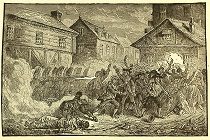Special thanks to our guest contributor Quincy Balius, Education & GOHI Manuscripts Intern at Ohio History Connection.
March is a particularly important month in early American history. Several key events in the American Revolution occurred in the Marches of 1765-1781. Britain passed the Stamp Act on March 22, 1765, and the Quartering Act on March 24, 1765. The Boston Massacre took place on March 5, 1770. Britain passed the first of the Intolerable Acts, the Boston Port Act, on March 31, 1774. On March 23, 1775, Patrick Henry gave his famous “Give me liberty or give me death” speech. Congress ratified the Articles of Confederation on March 1, 1781.
However, the American Revolution is about more than just political acts and military battles. It is also about freedom and the many contradictions and limitations of that freedom. For instance, African Americans, American Indians, and women did not share equally in the freedoms of the American Revolution, and their roles in the Revolution are often overlooked.
Teaching about the roles of Africans and African Americans, American Indian peoples, and women creates a more inclusive classroom that helps students see themselves in history. For example, consider teaching about diverse American history by analyzing espionage in the American Revolution. To this day, no one knows the identity of the single female spy in the Culper Ring, George Washington’s spy ring in New York during the American Revolution. The spies considered the female spy, Agent 355, an integral member of the ring. Agent 355 was one of the people who discovered Benedict Arnold’s defection and informed the Patriots. Her counterespionage was incredibly valuable to the success of the war, showing students the importance of women’s efforts in the American Revolution.

‘Battle of Bunker Hill’ illustration. Joseph T. Wilson. The Black Phalanx: A History of the Negro Soldiers of the United States in the Wars of 1775-1812, 1861-’65.
Educators might also consider telling students about James Armistad Lafayette, a Black man who was born into slavery in 1760 in Kent, Virginia. During the American Revolution, James worked with the Marquis de Lafayette to infiltrate General Cornwallis’s camp at Yorktown. James was one of the spies who ensured the Patriot victory at Yorktown, the turning point of the Revolutionary War. After the American Revolution, James returned to bondage in Virginia. He petitioned Congress for his freedom, and the Marquis de Lafayette wrote a letter to Congress on James’s behalf. James received his freedom in 1787 and a military pension in 1818. In honor of Lafayette’s impact on his life, James added the marquis’s name to his own.
Teachers can also discuss the role of American Indian tribes in the American Revolution. For instance, the Oneida, one of the six Iroquois Nations (Haudenosaunee), spied and fought for the Patriots in New York. The Oneida warned the Patriots of the August 1777 British attack on Fort Schuyler and spied on the British between 1777 and 1779.
Teachers should also describe the opposing roles that many American Indians, African Americans, and women took. Many people living in the American colonies also spied and fought for the British. Some people in these groups were Loyalists for a variety of reasons: family ties, British promises of freedom from slavery, Patriot infringement on Native lands, and more.
In the Declaration of Independence, “We the people” originally only included wealthy, white, male landowners. Teaching an inclusive history of the American Revolution allows students to see themselves in the modern-day American people. It’s important to also teach about the limitations of the American Revolution and the inequalities of freedom within a new nation. Not everyone enjoyed the same freedoms on July 4, 1776.
Check out these resources below to help you bring these diverse stories into your classroom. Do you have a resource you enjoy using with your students? Email us at [email protected].
American Indians & American Revolution
Women & American Revolution
African Americans & American Revolution
Espionage & Combined Sources
Blog image citation: ‘Battle of Bunker Hill’ illustration. Joseph T. Wilson. The Black Phalanx: A History of the Negro Soldiers of the United States in the Wars of 1775-1812, 1861-’65. Drawing. Washington, DC: American Publishing Company, 1891. National Afro-American Museum and Cultural Center. https://ohiomemory.org/digital/collection/p15005coll34/id/49. (Accessed February 20, 2022).